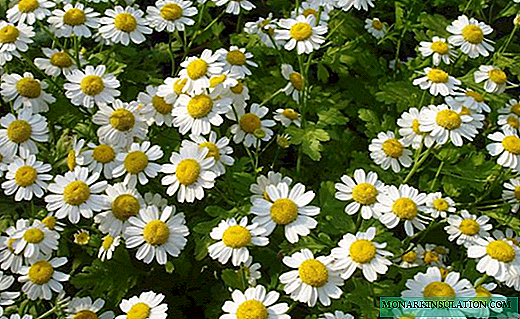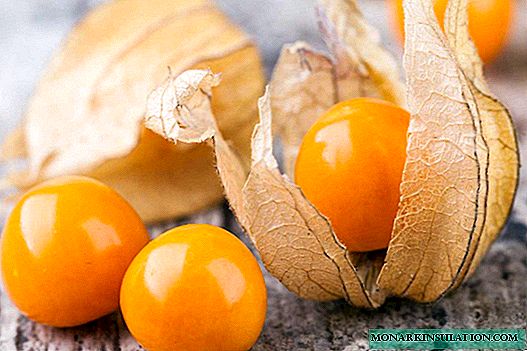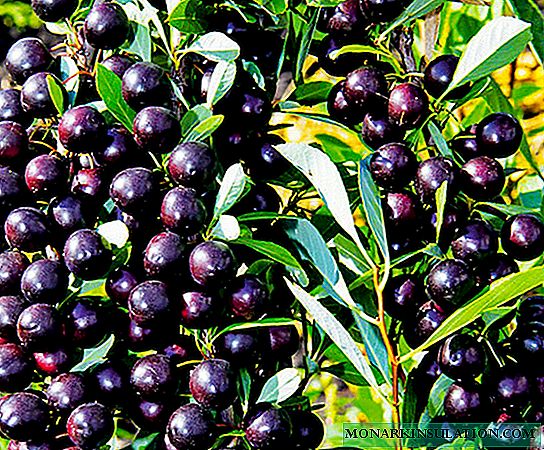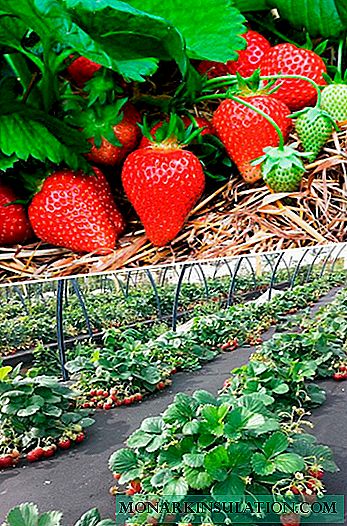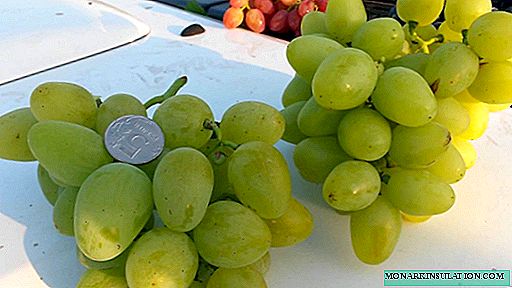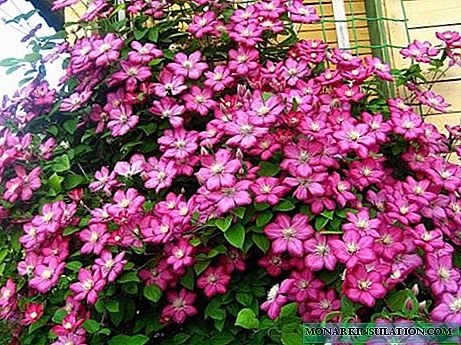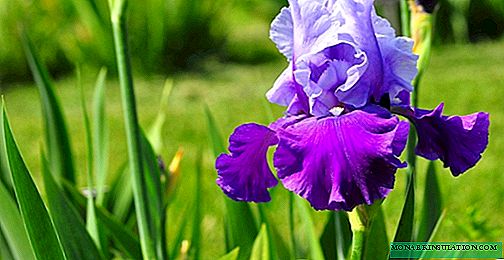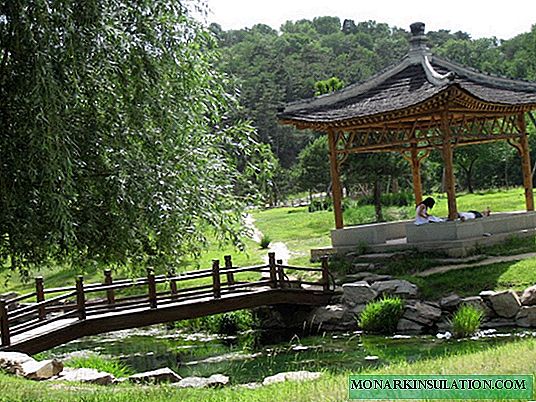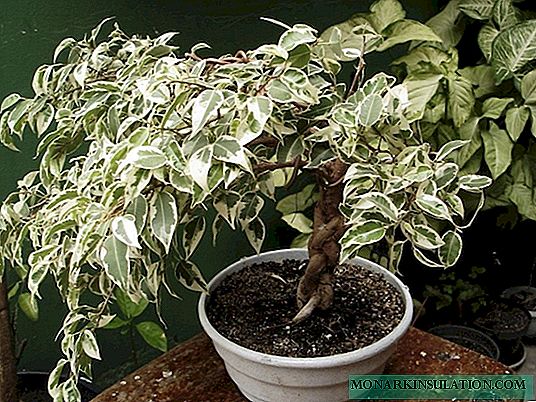
When the summer season is in full swing and gardeners have already done everything necessary in order to be able to get a crop, everyone starts to wait: what kind of fruits can be tasted first. In a wide variety of grapes among experienced gardeners, Muromets grapes have long been known as one of the earliest. Experienced growers know - this variety ripens first. Thanks to this property, Muromets has not lost its popularity in amateur gardening for more than half a century.
The story of the creation of the Muromets grape variety
Grapes Muromets was obtained at the Central Genetic Laboratory (CTF) them. I.V. Michurin in 1962 by crossing varieties Severny and Pobeda. CHF was created in 1935 on the basis of a fruit nursery, which was founded by Michurin.
The authors of the variety I. M. Filippenko and L. T. Shtin. Muromets inherited frost resistance and early maturity from the Northern grape variety, and the high yield and taste of berries were transmitted from the second “parent” (Pobeda). Muromets has been in state variety testing since 1977, and was included in the register of selection achievements of the Russian Federation in 1988.
Description and characteristic
Variety Muromets is a table and belongs to the group of black grapes. From the beginning of the growing season to the onset of full ripeness of the fruit, 105-110 days pass, which characterizes it as extra early. In most regions, berries ripen in early August.
The ripening period can vary both upward and downward. Its duration is influenced by climatic and weather conditions. There is evidence that in the southern climate, with steady hot and dry weather, the fruits were ready for use in the first half of July. In the northern regions, during cool and rainy weather, ripening of berries can be delayed until the second half of August or early September.
Early ripeness is the main advantage of the Muromets variety; it is difficult to find black grape varieties with the same early ripening period. In the southern latitudes, of course, there may be some alternative to this variety due to the large assortment of grapes for a warm climate. But in the northern regions, Muromets is the only variety that makes it possible to taste a delicious berry in such an early period. Therefore, it is very common in the northern zone of viticulture.
The variety is zoned in the North Caucasus, Lower Volga and Ural regions, but also in amateur gardening is also widespread in central Russia, Moscow region, North-West region, Siberia and the Far East.
Vigorous bushes of Muromets grapes are characterized by excellent ripening of shoots, almost 100%. A distinctive feature of the variety is the tendency to fasciation of the lower part of the main shoot.
Fascination of escape (from the Latin fascia - bandage, strip) - a manifestation of deformity, in which the shape of the stem changes. The shoots become ribbon-like and flat, their tip bifurcates - as a result, two growth points are formed. Cuttings cannot be harvested from such shoots.

In Muromets grapes, fascination of shoots is often observed
The clusters are quite large - 400-500 grams, can reach one kilogram. Their density is medium, the shape is conical.

A bunch of grapes Muromets large, conical shape
The berries are large, weighing 4-5 grams, elongated oval. By thinning berries in bunches, one can increase their size. Dark purple, almost black, the skin is covered with a thick coating of spring.
Pruin is a thin layer of wax coating that protects the berries from the adverse effects of external factors, such as: weather conditions, mechanical damage, microorganisms.

Large berries of the Muromets grape variety are oval and covered with a spring
The pulp is dense, crispy and juicy. The skin is thin, tearing. Inside the berry from one to four small seeds. According to some reviews, seeds may be missing. With excess moisture during ripening, the berries are prone to cracking.
Table: Agrobiological characteristics of Muromets grapes
| Signs | Indicators |
|---|---|
| General information | |
| Originator | TGL them. I.V. Michurina |
| Direction of use | Table |
| Bush | |
| Growth power | Tall |
| Shoots ripening | almost to the end of growth |
| Bunch | |
| Weight | 0.4-0.5 kg (up to one kilogram) |
| The form | Conical |
| Density | Average |
| Berry | |
| Weight | 4-5 g |
| The form | oval |
| Color | dark purple with a touch of spring |
| Taste properties | |
| Character of taste | simple, harmonious |
| Sugar content | 18% |
| Acidity | 4.4 g / l |
| Household signs | |
| Ripening period | Very early (105-110 days) |
| Flower functionality | Bisexual |
| Productivity | High |
| The percentage of fruitful shoots | 70-90% |
| Frost resistance | 25-26 ° C |
| Disease immunity | Average |
| Transportability | Good |
| Keepiness | 1-2 months stored |
The taste of grapes is simple, without aroma. Some gardeners note that when fully ripened, tones of "rose petals" appear. A balanced combination of sugar content (18%) and acidity (4.4 g / l) makes it harmonious.
Video: Muromets grape review
Cuttings are highly rooted. You can grow seedlings on your own at your dacha, and if you apply picking, then root-forming preparations will not be needed.
Sowing - an agricultural technique used in the cultivation of seedlings. It accelerates the formation of root primordia and simultaneously slows the opening of the eyes. To do this, the lower end of the handle is placed in conditions of elevated temperature (26-28 ° C) and humidity (85-90%), and a lower temperature (0-5 ° C) acts at its opposite end at this time.
Variety Muromets is high-yielding, the proportion of fruitful shoots is 70-90%. From one bush you can collect up to 10-15 kg of berries. Since the flower is bisexual, the ovary usually forms well. It is necessary to take into account some factors that may affect yield. When overloaded, the berries can ripen in the upper part of the bunch, and from the bottom dry off unripe, therefore it is recommended to apply crop rationing. If the weather is not warm enough during flowering, peeling may occur.

Cool weather during the flowering of grapes Muromets contributes to the berries
If during the ripening of the crop, rainy weather established and the berries began to crack, then the crop will have to be removed unripe. Fruits can be used to make jam or compote. In the absence of rain, the clusters can be on the bushes for quite a long time, according to the reviews of wine growers 1-1.5 months, while they are well preserved and gain sugar.
When a ripe crop is harvested in dry weather, it is well transported. You can store grapes for one to two months in a cool place or in the refrigerator.
A fairly high frost resistance (25-26 ° C) of the variety allows it to be grown in many regions without shelter, while the risk of freezing of the vine is 10-20%. There is information about the successful cultivation of grapes in non-covering form at temperatures up to -30 ° C. At lower winter temperatures, the bushes need to be covered. The variety tolerates drought well.
Grape immunity to diseases is average. Relatively resistant to mildew, and increased susceptibility to oidium and gray rot. From pests, standard prophylactic treatments are sufficient. This grape variety is susceptible to damage by wasps.. Birds do not touch him.
Advantages and disadvantages of the variety
Muromets grapes are popular due to their following advantages:
- very early ripening;
- large clusters;
- large berries covered with pruin;
- balanced taste;
- good transportability;
- high productivity;
- bisexual flower (high pollination under favorable conditions);
- increased frost resistance (grown in many regions without shelter);
- resistance to drought;
- good rooting of cuttings;
- almost complete ripening of shoots.
But the variety has a certain number of disadvantages that are very important to know:
- tendency to pea with a lack of heat;
- requires rationing with inflorescences and berries (prone to overload by crop);
- cracking of berries with high humidity during ripening;
- instability to oidium and gray rot;
- damaged by wasps.
With a significant number of advantages of this variety, it must be taken into account that some of its disadvantages can lead to loss of yield. The main disadvantage of Muromets grapes is their susceptibility to oidium and gray rot. The tendency to cracking and damage by wasps contributes to the development of these diseases, since berries with impaired skin integrity become more vulnerable to microorganisms.
However, many gardeners, following all the recommendations for growing this variety, successfully cope with all its weaknesses and get high yields of early delicious berries.
Features of varietal agricultural technology grapes Muromets
The Muromets grape variety has a number of features, so it needs to be provided with appropriate care. Much depends on climatic conditions, but a good crop can be obtained in any region, subject to recommendations for cultivation.
Landing
When planting Muromets, you need to consider that it is better to plant it on slightly acidic and neutral soils (pH 6-7). High lime soils are not suitable. The landing site is chosen on the south side with a slope of up to 10 °. A sufficient slope will contribute to a good ventilation of the vine and to prevent stagnation of excess moisture.
The recommended arrangement of bushes is 1.25-1.5x2.5-3 m. Otherwise, there are no special requirements for planting this variety. As for other vigorous varieties, pits of 80x80x80 cm in size are prepared in advance, in which drainage is placed. Fertile soil seasoned with organic and mineral fertilizers is poured into moistened pits and plants are planted.
You can plant Muromets grapes in autumn and spring. Autumn planting is not recommended for the northern regions due to the risk of freezing of seedlings.
Shaping and trimming
Formations for grapes Muromets can be used differently, while all methods should create favorable conditions for maximum ventilation of the vine. In case of uncultivated cultivation, the bushes are formed in the form of a bilateral horizontal cordon; cultivation on the arch (arbor) and on the visor is also used. It is noted that with the withdrawal of vines on the peak and on the arch, the largest clusters and berries are obtained. If the plant is planned to be covered, then use a fanless fanless formation on 4-6 sleeves.
Photo Gallery: Methods of Forming Muromets Vine Bushes

- Bushes of the Muromets variety are formed in the form of a bilateral horizontal cordon

- Muromets grape bush grown on an arch (arbor)

- The vines of Muromets grapes are brought to the peak (to the roof)

- When covering the Muromets cultivar in a sheltered manner, a fanless stamping is used
The fanless, multi-sleeve, non-stemmed design facilitates sheltering of grapes for the winter. The shoots tied in friable bunches are laid in trenches and insulated with natural material (burlap, plaids, reeds, straw mats), covered with a film on top.
Video: four-arm formation of a two-year-old vine bush of Muromets
Pruning of the fruiting vine is carried out for 8-10 eyes, while the total load on the bush is 40-45 shoots. Two or three inflorescences are formed on the shoots, so it is necessary to normalize the crop. It is recommended to leave one inflorescence per shoot.
Watering
Particular attention should be paid to the watering regime of the Muromets grape, as excess moisture during the ripening period can provoke cracking of the berries and the disease with gray rot, which can be fatal for the crop. With regard to watering this variety, there are no uniform recommendations, it all depends on the specific climatic conditions, but a wet-charged autumn watering is required for any region.
If the climate is arid, then without sufficient watering there will be no large berries and a large crop. In such regions, grapes are watered in the spring immediately after the vine is opened, and during the growing season once every two weeks before the softening of the berries begins. After this, watering is stopped before harvesting.
In humid climates, you can limit yourself to the standard irrigation regime for early varieties. In addition to autumn water recharge, plants must be watered during budding and after flowering. If the rainfall in the summer season is less than the climatic norm, the number of irrigations is increased.
Top dressing
Muromets is fed standard fertilizers for grapes and at normal times. Top dressing improves crop ripening, especially under heavy load.
Table: dates and types of dressing grapes Muromets with mineral fertilizers
| Feeding Times | Types of fertilizers |
|---|---|
| Spring (at the beginning of the growing season) | Nitrogen and phosphoric |
| Before flowering (two weeks) | Phosphorus and nitrogen (the amount of nitrogen fertilizers is reduced in comparison with spring top dressing) |
| At maturity | Phosphoric |
| After harvest | Potash |
After liquid top dressing, the soil around the trunk is mulched with organic materials (hay, rotted sawdust, mowed grass, etc.), which protect the soil from drying out and weeds.
Organic fertilizers on fertile soils are applied together with autumn digging once every 3 years. As organics, you can use humus, manure and compost.
Diseases and Pests
According to the description of the originator, Muromets grapes have increased immunity to mildew and are unstable to oidium and gray rot, as evidenced by the responses of winegrowers who cultivated this variety.
Oidium (powdery mildew) is caused by a pathogen fungus that infects the ground green parts of the bush. Leaves, green shoots, inflorescences and berries are covered with powdery coating, which over time acquires a grayish tint. Then the leaves and inflorescences fall off, and the berries stop growing and dry on the bunches.
Photo gallery: oidium-affected parts of the vine bush

- Oidium-affected grape leaves

- Oidium-affected grape brush comb

- Oidium-affected grape berries

- When oidium berries dry on bunches of grapes

- Oidium-affected vine
Disease prevention measures are:
- proper formation, providing good ventilation of the bushes;
- control over the dosage of nitrogen fertilizers, since their excess contributes to the development of the disease.
Sulfur and its preparations are best used in the fight against oidium. Infected plants are treated with dry powder or sprayed with sulfur-containing fluids.
If in the previous year there was an oidium on the bushes, then the first spraying of 1-2% with a calcareous broth is carried out in early spring before buds open. During the growing season, suspensions of colloidal sulfur or dry ground sulfur powder are used. The action of sulfur after treatment lasts for 10 days, after which after 5 days new spores of the fungus can germinate. With a strong outbreak of the disease, treatment is repeated every 15 days. Usually, one or three treatments are sufficient. Between the last treatment of plants with sulfur and harvesting, at least 56 days must pass.
No less dangerous disease of grapes is gray rot. Its causative agent is mold, which can affect the entire bush, but the berries cause the most damage during the ripening period. The spread of the disease contributes to increased humidity and violation of the integrity of the skin. Signs of gray rot are slimy berries with powdery plaque.

Affected by rotten grapes, the berries are covered with powder coating, become mucilage
To deal with gray rot is very difficult. Most known chemicals to fight this disease are either not toxic enough to spore the parasite, or affect the quality of the berries and are not harmless.From the means recommended by specialists for combating gray rot, plants can be sprayed with fungicides: benlat, phthalan and euparen. They do this before flowering and after its completion, as well as when the berries have reached the size of a pea. If necessary, the treatments are repeated, but it is important to remember that they are stopped 40 days before the harvest.
The agrotechnical method of control is the prevention of the disease and the mechanical removal of the infected parts of the bush. It is necessary to apply a formation with a high stem (where possible) in order to improve the air permeability of the bush. On fan-shaped formations, the clusters must not be allowed to touch the ground, they must be tied up. It is very important not to abuse nitrogen fertilizers and not to overload the bushes with the crop. If gray rot occurs during the ripening period, you must immediately harvest the crop, even if it has not yet ripened. It is also necessary to destroy infected leaves and berries in time.
Of the pests, wasps can cause the greatest damage to the harvest of Muromets. For the Muromets variety, it is very important to prevent damage to the berries, since a violation of their integrity can provoke the disease with gray rot. Wasp control can be carried out in several ways. There are methods that lead to the death of wasps:
- destruction of wasp nests;
- the use of various traps with baits that emit an intense odor;
- the use of poisoned baits.
Ways in which wasps do not die:
- scaring off by spraying grapes with non-toxic substances with a strong smell (wine or table vinegar);
- chemical deterrence by spraying with non-toxic wasps (for which grapes will need to be thoroughly washed before use);
- isolation of bunches with the help of special protective bags made of mesh (can be reused for several years).
Of all these methods, the latter is the most environmentally friendly and efficient, but at the same time the most costly and time consuming. However, it should be remembered that wasps do not only harm grapes, but also benefit - they actively destroy bugs, caterpillars, and aphids.

Protecting grapes from wasps with mesh bags is a time-consuming method, but the most effective and environmentally friendly
To other pests, the variety does not show particular sensitivity. If necessary, you can combine preventive spraying with insecticides with the treatment of plants against fungal diseases.
Reviews
I really like Muromets. Pluses: very strong growth, early staining and ripening, lays clusters on stepsons, with good ripening - very sweet, high frost resistance, excellent pollination, remains on the bush for a long time and gathers sugar, does not burst. Cons: resistance to mildew and oidium is average, the shoots are very fattening and can break off if not ripened - the taste is grassy, and of course - wasps do not fly by.
Anatoly BC//forum.vinograd.info/showthread.php?t=559
My Muromets bears fruit for four years. Pollinated well. The taste is pleasant, so unobtrusive - you can eat a lot, do not bother. I did not notice much pain in myself. Always ripened, even with a slight overload, last year the stepson crop also matured. I met in the descriptions that he was cracking hard, but he did not observe at home. IMHO is very suitable for our zone grade
Evgeny_vrn//forum.vinograd.info/showthread.php?t=559
Muromets always has a very large leaf, even if you do not feed at all, apparently a varietal feature. It winters with me just on the ground, and if there is very severe frost and snow, then the crop is modest, apparently the side buds do not give out a crop, and it’s very good and early (in July it is all eaten up). Rooted cuttings immediately give out all the shoots with the laying of inflorescences, moreover, large ones, so you need to monitor and clean them. In rainy weather, when the flowering takes place, there is a peeling of berries, but this does not spoil, the berries are generally seedless.
FTI//forum.vinograd.info/showthread.php?t=559&page=2
Muromets this year matured before all large-graded varieties and was fully ready for August 5-10. Sustainability is slightly higher than last year. I noticed an oidium on berries in time, sulfur helped a lot. Bush on the gazebo (vaccination). In total this year 30 clusters, a total weight of 20.4 kg, an average cluster weight of 680 grams. Bush on the roof of the veranda (vaccination, first fruiting). In total there were 8 clusters, a total weight of 6.0 kg, an average cluster weight of 750 grams.
Anatoly BC//forum.vinograd.info/showthread.php?t=559&page=3
I liked Muromets for its taste, early ripening and frost resistance. The taste is simple but pleasant, you can eat a lot with pleasure. The flesh is crisp, the skin, when cracked, bursts and crunches, absolutely does not interfere. There is one more feature. It can be eaten already at the beginning of staining, in contrast to other dark-colored varieties and g / f. But all these positive qualities were crossed out by cracking in my area. Muromets instilled in three different places on different stocks and the result is the same. Cracked on my site the very first and continues every day for 2-3 berries in a bunch to burst. We have rains every other day.
Khaetskiy Igor Yuryevich//forum.vinograd.info/showthread.php?t=559&page=4
I have a Muromets since the mid-90s. Over the past period did not hurt. This year there are varieties located around: First Swallow, Riddle of Sharov, Early Magaracha were very sick with mildew, but Muromets was not. He gave a wonderful harvest. The berries are large, beautiful, ripened here in Siberia in early September. The clusters, however, are medium: grams 250-300, but the berry is no worse than a cardinal. And it’s nice to eat, and it took a lot of wine. With what, and I’m very pleased with Muromets. By the way, the skin burst during precipitation only once. I plan to expand the landing, though it does not matter. And last year, cold for us, he was the only one who ripened well. Winter hardiness is magnificent, practically does not freeze. True, you need to trim long. But the load can be adjusted in the spring. As I was convinced, it is better to leave one inflorescence on the shoot, although it can withstand (when feeding) two.
legioner//forum.vinograd.info/showthread.php?t=559&page=5
My Muromets has been growing on my site for more than 15 years. Matures in early August, before the Beauty of the Don. The color is blue, the berries are 5-6 g in size, of a simple taste, the brushes are dense (because of which they crack), weighing from 350 g to 1.5 kg. Ripe grapes are not stored on the bushes, urgently need to cut it. It responds well to dressing. Has time to ripen to mildew on the leaves. There were no other diseases on the bush. Productivity is stable, high, 10 - 20 kg and more. Trimming 6-8 buds, leave no more than 2 brushes on the shoot (it draws more, but the berries are smaller, the brushes too). It grows poorly in the shade. The favorite of sparrows, flies and wasps. Be sure to set traps for wasps, stretch white threads from birds along the bush. More than a day is not stored. He has one feature from the whole grape-bursting berries (to flies and wasps) overgrow 2-3 times on one berry. No nutmeg, overripe becomes sweet 16-18%, sometimes there are berries without seeds. The vine ripens very well, the bush is overgrown, the leaves are very large. He loves watering, then almost does not crack. Frost resistance -25g. Cuttings are well received. Grapes for the northern regions.
Gukovchanin//forum.vinograd.info/showthread.php?t=559&page=6
Muromets has good qualities. For example, winter hardiness. And on good soil and with sufficient moisture, it gives an excellent crop (by the way, if the bush is overloaded with crops, you can remove the lower parts of the clusters and thus correct the situation - one of the bushes had to be "cut" this year). However, in rainy years without chemical. treatments cannot be done - otherwise by the end of the season you will have a visual aid on the topic "fungal diseases of grapes" on the site. You just need to consider the features of this variety. At our place, Muromets succeeds with: sufficient food area; good ventilation; moderate load (and in the early years I could not force myself to remove a bucket of inflorescences from Muromets, and as a result I got "disgrace"). In this dry year for our area, and even after a difficult winter, he showed himself remarkably. Despite the fact that the variety is rather painful, we are not going to reduce the number of bushes yet, because its simple taste does not bother, and early ripening is a huge plus. But most importantly - he is uncovered.
Kirei Yuri//forum.vinograd.info/showthread.php?t=559&page=8
My Muromets has been growing on the gazebo for the 8th year. For the winter, the bush does not cover our frosts withstands without much loss. Disease resistant for season 3 treatments. Cons - wasps are very fond of, with long rains the berry bursts, large bones 3-4 in the berry.
Vadim//forum.vinograd.info/showthread.php?t=559&page=10
In this “terrible” year from precipitation and low temperatures, one of the few ripened (scored a normal amount of sugar - somewhere around 17 percent). Surrounded by mildew - not sick. The vine, despite the high load, has matured already more than half a meter. Berries after early frosts were not damaged unlike other varieties. The variety, in my opinion, is very decent for the north, but is struck by oidium.
legioner//forum.vinograd.info/showthread.php?t=559&page=13
Muromets grapes have long been known and widely distributed in various regions. Gardeners appreciate it for its early maturity, high productivity and frost resistance. Thanks to this combination of properties, it is simply indispensable for the northern latitudes. The variety has some features, so when growing it, you will need to carefully follow the recommendations. For this you will have to make an effort, but hard work and perseverance will not be left without a reward, it will be the opportunity to eat tasty and healthy berries in the earliest possible time.










